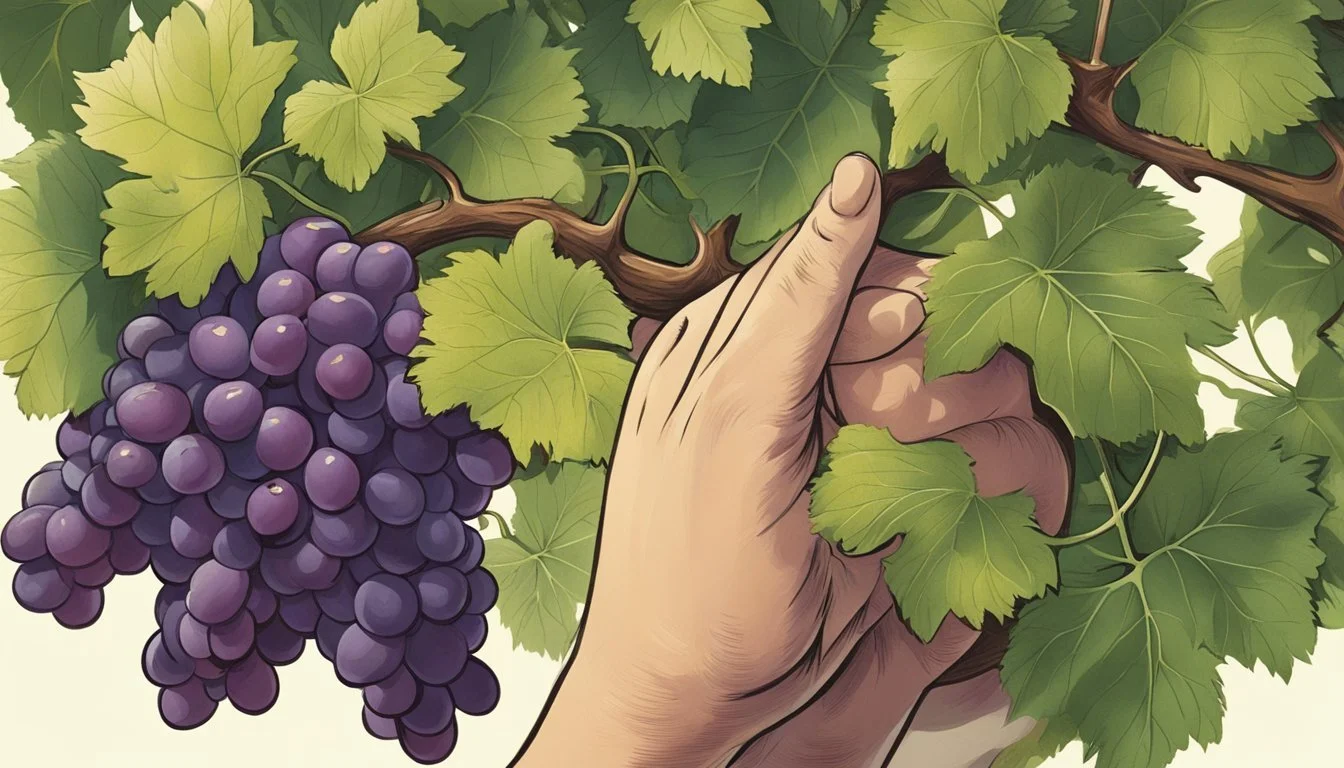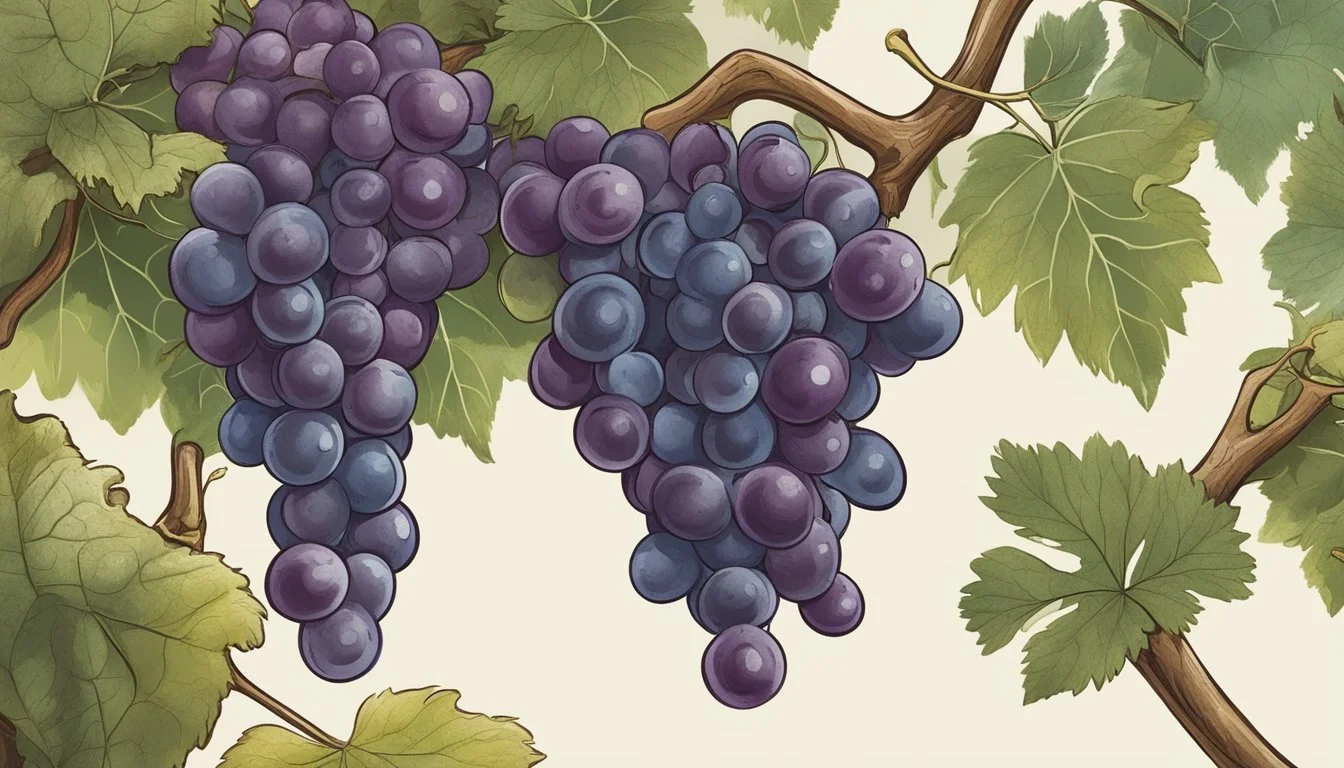How Do You Eat a Grape?
Unveiling the Simple Techniques
Grapes are versatile fruits enjoyed by many for their juicy and sweet flavor. They are typically consumed raw and can be found in various varieties including seedless, red, green, and black. Eating grapes is as simple as plucking them off the stem and popping them into one's mouth. However, there are a few steps one can take to ensure a pleasant grape-eating experience.
Before eating grapes, one should always wash them thoroughly to remove any potential residues or contaminants. They can be eaten with or without the skin, which is edible, though some may prefer to peel them due to texture preferences. Grapes are commonly chilled before eating for an extra crisp bite but can be enjoyed at room temperature as well.
For those who wish to preserve grapes for later use, freezing is an effective method. One can rinse and dry the grapes, then place them individually on a baking sheet to freeze, preventing the grapes from clumping together. Once frozen, they can be transferred to a freezer-safe container for long-term storage. Frozen grapes make for a refreshing snack, particularly in warmer weather, and can also be used as an alternative to ice cubes in drinks.
Varieties and Characteristics
Grapes come in a multitude of varieties, each with distinct color, form, and nutritional value. They vary from table grapes to varieties used in wine production. This section explores the varying characteristics of grapes and their intrinsic nutritional profiles.
Color and Form
Grapes typically fall into three color categories: red, green, and black. Red grapes tend to have a sweet and slightly tart flavor profile, while green grapes, often called white grapes, are crisper with a higher acidity. Black grapes range from sweet to tannin-rich flavors. The form of grapes can be found in spherical, elongated, and small to large sizes. Seedless varieties such as the Flame Seedless or the Autumn Royal are prevalent in North America for their convenience and large berry size.
Nutritional Profile
Grapes are a low-calorie food, rich in vitamins and nutrients essential to health. A single cup of seedless grapes typically contains:
Calories: Approximately 62
Carbohydrates: 16g
Fiber: 0.8g, 3% of Daily Value (DV)
Protein: 0.6g
Fat: 0.3g
They provide a good source of vitamin C, vitamin K, and potassium. Grapes also carry a variety of antioxidants, including flavonoids and polyphenols, which can mitigate damage caused by free radicals.
Types of Grapes
Table grapes are types specifically grown for direct consumption. Examples include:
Sultanas: Small, light green, and oval-shaped with a high sugar content.
Flame Seedless: A red variety known for its sweetness and firm texture.
Autumn Royal: A dark, indigo-black grape, larger in size and seedless.
North America, along with regions like Turkey and Australia, is known for the production and consumption of these varied and nutritious grape types. Each offers a unique taste and texture experience and contributes to a versatile serving options in the kitchen, from fresh consumption to inclusion in a range of sweet and savory dishes.
Health Benefits of Grapes
Grapes are not only a popular fruit choice but also come with a multitude of health benefits, from their rich nutrient content to their impact on chronic diseases. Each variety, be it red, purple, or green, brings valuable components to the table, contributing to overall health and wellness.
Antioxidants and Free Radicals
Grapes are laden with antioxidants such as resveratrol, anthocyanins, and catechins. These compounds help neutralize harmful free radicals, which are linked with aging and numerous chronic diseases. The darker the grape, typically the higher the antioxidant content.
Heart Health
The antioxidants in grapes contribute to heart health by potentially reducing blood pressure and cholesterol levels. They also support the vascular system and can improve the function of the blood vessels, thereby contributing to a lower risk of heart disease.
Potassium: Essential for maintaining heart health, found abundantly in grapes.
Resveratrol: Has been studied for its effect on protecting the endothelium, the lining of blood vessels.
Regulation of Blood Sugar
Despite their sweetness, grapes have a relatively low glycemic index, which means they may have a lesser impact on blood sugar levels. Moreover, the polyphenols in grapes can help with insulin sensitivity, making them a fruit option that can be included in a diet for those managing diabetes.
Fiber Content: Helps in the slow release of glucose into the bloodstream.
Anti-inflammatory Properties
Chronic inflammation is a root cause of many illnesses, and the anti-inflammatory compounds within grapes help combat this. Resveratrol particularly has been noted for its anti-inflammatory effects, which could be preventive against certain chronic conditions.
Benefits for Brain Health
Consuming grapes may have positive effects on the brain and help improve aspects of brain health including memory, attention, and mood. The polyphenols in grapes aid in maintaining brain function and may slow down the progression of neurodegenerative disorders like Alzheimer’s disease.
Vitamin K: Crucial for cognitive health.
Sirt1 gene activation by resveratrol: May protect against the onset of age-related cognitive decline.
Cancer Prevention
Components found in grapes, like resveratrol, have shown potential in cancer prevention. They may help prevent the formation of cancer cells and also assist the immune system. Studies indicate that grapes may offer some protective benefits against certain cancers, though more research is needed to fully understand this relationship.
Vitamin C: Known for its role in the body's immune function, which can combat the onset and progression of diseases including cancer.
Consumption and Usage
Grapes are versatile fruits that can be consumed fresh or used in a variety of culinary preparations. From being a key ingredient in various dishes to the formation of grape-derived products, grapes are enjoyed in many forms.
Incorporation in Meals
Grapes, be it green, red, or table grapes, are commonly incorporated into meals. They can be tossed into a fruit salad with melons and berries or added to a chicken salad for a burst of sweetness. A nutritious addition to any dish, grapes can also pair well with nuts and cheese, offering a balanced flavor profile.
Meal Type Grape Usage Breakfast Added to cereal, oatmeal or yogurt Lunch & Dinner Mixed in salads, or served as a side Snacks Paired with cheese, nuts, or as a fresh fruit option
Grape Products
Beyond fresh consumption, grapes are processed into various products. Grape juice is a popular beverage, high in vitamins and often preferred for its antioxidant properties. Wine, made through fermenting grapes, is an elegant product enjoyed globally. Raisins, which are dried grapes, are a convenient snack and a sweet addition to baked goods or granola.
Raisins: Used in granola, cookies, muffins, bread, curry, savory sauces
Grape Juice/Wine: Enjoyed as beverages or used in cooking
Creative Preparations
Chefs and home cooks alike enjoy creating innovative grape recipes. Grape smoothies are a refreshing option, combining nutrient-rich grapes with other fruits. Grapes can be roasted or grilled, enhancing their sweetness, and then used as an accompaniment to meats. Additionally, grapes are turned into jams, a delightful spread for toasts and sandwiches.
Grape Smoothie: Blend with other fruits for a refreshing drink.
Roasted/Grilled Grapes: Serve with savory dishes like roasted chicken. (What wine goes well with roasted chicken?)
Jams: Spread on toast or use as fillings for pastries.
Through these diverse methods of consumption and usage, grapes continue to be a staple in the kitchen, offering a combination of nutrition, flavor, and versatility.
Pairings and Recipes
Eating grapes goes beyond simple snacking; they can be a dynamic ingredient paired with diverse foods or incorporated into recipes. Their sweetness and acidity make them ideal for balancing flavors in both savory and sweet dishes.
Food Pairing
Cheese is a classic partner for grapes, with the saltiness and creaminess of cheeses like blue cheese or goat cheese complementing the fruit’s natural sweetness and acidity. Grapes also work well in salads, bringing a juicy burst of flavor that can enhance the overall taste profile. For a more substantial meal, grapes can be added to a chicken salad, providing a sweet note that contrasts with the savory chicken.
Grape Pairing Food Item Suggestion Cheese Blue cheese, goat cheese, Brie Nuts Almonds, pecans, walnuts Wine Complement with a crisp white wine or rosé Salads Toss with arugula, spinach, or a fruit salad
Grape-Infused Recipes
One may incorporate grapes into various recipes to elevate the dish’s complexity and flavor dimensions. Grape recipes can range from simple to intricate, suitable for all levels of culinary expertise. A refreshing grape smoothie combines the fruit with yogurt and a touch of honey for a nutritious blend. For appetizer options, grapes can be roasted and added to crostini with ricotta cheese or tossed into a nutty fruit salad.
Example Grape-Infused Recipes:
Grape Parfait: Layer grapes with yogurt and granola for a satisfying breakfast.
Chicken Salad with Grapes: Mix diced chicken, halved grapes, and a creamy dressing for a delightful twist on the classic sandwich filler.
Fruit Salad: Combine grapes with other fruits like melon and berries for a fresh salad, perfect for summer picnics.
Incorporating grapes into culinary creations not only adds natural sweetness but also a colorful aesthetic that can make any dish visually appealing as well as delicious.
Grape Cultivation
Grape cultivation is a detailed process that varies with grape types and regions. It encompasses the planting of vines, the careful nurturing until harvest, and the processes specific to wine grape cultivation.
Growing Grapes
Grapes grow in a variety of climates, but they generally prefer full sun and well-drained soil. North America is home to numerous grape varieties including table grapes like the Moon Drop and wine grapes which have specific regional preferences.
Site Selection: Vines require an area with adequate sunlight and airflow.
Planting: Space vines 6 to 10 feet apart, with muscadines needing up to 16 feet. Begin with a hole 12 inches deep and 12 inches wide, lined with 4 inches of topsoil.
Pruning: This is key to managing vine health and ensuring good fruit production. Only a few buds should be left on each vine to produce the following year's growth and fruiting canes.
Harvesting and Storage
The right time to harvest grapes depends on their intended use, sugar content, and acidity levels.
Table Grapes: Harvest when they are full-colored and taste sweet.
Wine Grapes: Wine makers prefer grapes with the right balance of sugars and acids for fermentation.
Storage: After harvest, table grapes are kept in cool conditions to extend their shelf life, whereas wine grapes are often processed fairly quickly.
Wine Grape Cultivation
Cultivating grapes for wine making is a precision-driven segment of grape farming, often associated with the term viticulture.
Climate: Wine grapes have specific climate requirements; for instance, merlots and cabernets thrive in warmer climates, while pinot noir and chardonnay prefer cooler regions.
Soil: The soil's composition can influence the grape’s flavor, known as its terroir.
Harvesting: Wine grapes are sometimes harvested later to achieve a higher concentration of sugars, essential for a robust fermentation process.
In both table grape and wine grape cultivation, the choice of cultivars is paramount, with each type having specific requirements and characteristics ideally suited to the region's climate and soil.
Nutritional Information
When examining the nutritional profile of grapes, one is looking at a fruit that is not only refreshing but also packed with various nutrients. According to the USDA, grapes are low in calories, with a cup of grapes (approximately 151 grams) containing only about 104 calories. They are predominantly composed of water and carbohydrates, with water constituting a significant portion of their weight, offering a hydrating experience to the consumer.
The same serving size, 1 cup of grapes, offers the following nutrients:
Carbohydrates: 27 grams
Protein: 1 gram
Fat: 0.2 grams
Sodium: 2 mg
Fiber: 1 gram
Sugars: High in natural sugars
The fiber content in grapes contributes to the recommended daily fiber intake, aiding in digestive health. Grapes also contain a variety of bioactive compounds, including antioxidants like resveratrol and quercetin. These antioxidants are known for their potential health benefits, which can include supporting the retina and promoting cardiovascular health.
As nutrient-dense berries, grapes provide more than just energy; they offer a range of vitamins and minerals that support overall well-being. However, their sugar content should be considered for those monitoring glucose intake. Despite this, the health benefits of consuming grapes, regarding both raw fruit and as constituents of products like wine, are recognized, although the health impacts can differ based on the form in which grapes are consumed.
Potential Health Concerns
When consuming grapes, individuals should be aware of potential health concerns such as allergic reactions, and the fruit’s role in weight management due to its sugar content.
Allergies and Sensitivities
Some individuals may experience allergic reactions to grapes, which can range from mild to severe. Symptoms of a grape allergy can include itching, hives, or even anaphylaxis in rare cases. Additionally, grapes contain salicylates, natural chemicals that can cause sensitivity in people with intolerances, resulting in symptoms such as headaches or digestive issues.
Grapes in Weight Management
Grapes contain sugars and carbohydrates which can influence blood sugar levels, making portion control important for those managing weight or with diabetes. A serving of grapes typically has:
Calories: Around 100 calories per cup
Carbohydrates: Approximately 27 grams per cup
Grapes have a medium glycemic index, which means they can cause a moderate rise in blood sugar. However, they also provide dietary fiber, which can help modulate blood sugar spikes. While grapes are not high in calories, their sugar content should be considered in the context of an individual’s total dietary intake, particularly for those monitoring their carbohydrate consumption for conditions like diabetes or looking to maintain heart health, given the importance of managing cholesterol and sugar levels.
Scientific Studies
Scientific research has provided insight into the specific health benefits of grapes and their impact on human wellness, particularly in areas related to cardiovascular health and blood sugar management.
Grapes and Cardiovascular Research
Studies have indicated that grapes are a source of antioxidants like resveratrol, which may reduce the risk of heart disease by preventing platelet buildup and lowering blood pressure. Research focusing on cardiovascular health suggests that these antioxidants can help reduce oxidative stress and inflammation, both of which are contributors to heart disease.
Another component observed in grapes, melatonin, is noted for its potential protective effects on the heart. Grapes also contain iron and calcium, which are essential for maintaining heart health.
Glycemic Research
Grapes have a relatively low glycemic index, and studies have examined the impact of grape components on blood sugar levels. Insulin sensitivity may also be improved with the regular consumption of grapes, as indicated by some research. This factor is significant in the management and protection against diabetes.
These benefits are tied to not only the whole fruit but also derivative products such as wine, which, when consumed in moderation, has been correlated with certain health advantages. However, it is crucial to note that excessive wine consumption can negate these benefits and introduce health risks.
Preservation Methods
To maintain the quality and extend the shelf life of grapes, one can employ various preservation methods. These techniques ensure grapes remain fresh and tasty for consumption or use in recipes.
Refrigeration Techniques
Refrigeration is crucial for preserving the hydration and freshness of grapes. They should be stored at temperatures between 30-32 degrees Fahrenheit and at 90-95% humidity. One may store them in the crisper drawer of the refrigerator, avoiding placement near strong-smelling foods to prevent odor absorption.
Freezing Methods
For longer preservation, grapes can be frozen. To freeze grapes, it’s recommended to rinse and dry them thoroughly, then lay them out on a cookie sheet without touching to prevent clumping. Once individually frozen, they are transferred to a freezer-safe container. Frozen grapes are not only preserved for future use but can be enjoyed as a cool snack or used as ice cubes in drinks.
Environmental Impact
The environmental impact of grape consumption extends from the cultivation of vines to the moment grapes reach the consumer. This impact involves water usage, land management, and the application of farming practices that can either harm or protect ecosystems.
Sustainable Practices
Vineyards are adopting sustainable practices to mitigate their environmental footprint. Water management is critical, as vines require approximately 25-30 inches of water annually. Drip irrigation is a common technique that delivers water directly to the roots, reducing wastage. Moreover, cover crops can be planted between vine rows to improve soil health and reduce erosion. The use of renewable energy sources, like solar panels, helps vineyards lower their carbon footprint.
Sustainable practices also involve careful land management. Vines naturally contain flavonoids, which are beneficial compounds for human health; however, the manner in which vineyards manage the land impacts these beneficial compounds. The protection of natural habitats around vineyards maintains biodiversity and the health of the ecosystem.
Pesticide Use
Pesticide use in vineyards has been a topic of concern due to its potential negative effects on the environment. They can cause harm to wildlife and contribute to a decline in bee populations, which are vital for pollination. Therefore, grape growers are increasingly turning to integrated pest management (IPM) strategies. IPM is a sustainable approach to managing pests by combining biological, cultural, physical, and chemical tools in a way that minimizes economic, health, and environmental risks.
Biological: Utilizing beneficial insects to control harmful pests.
Cultural: Implementing crop rotation and pruning to disrupt pest life cycles.
Physical: Employing barriers to protect vines from insects.
Chemical: When necessary, applying pesticides that are less toxic and more targeted.
By focusing on these practices, grape production can work towards a reduced environmental impact while maintaining the quality and health benefits of grapes.











